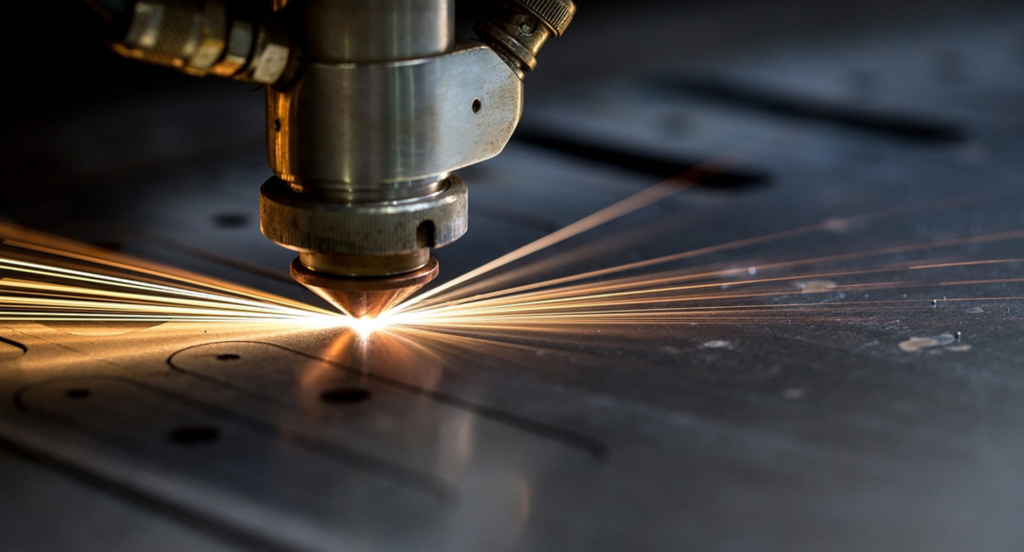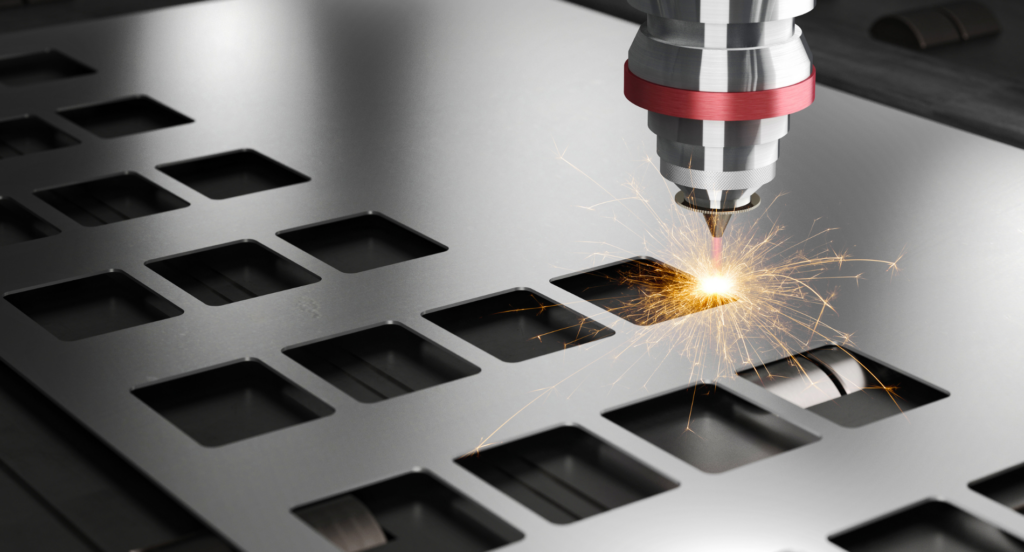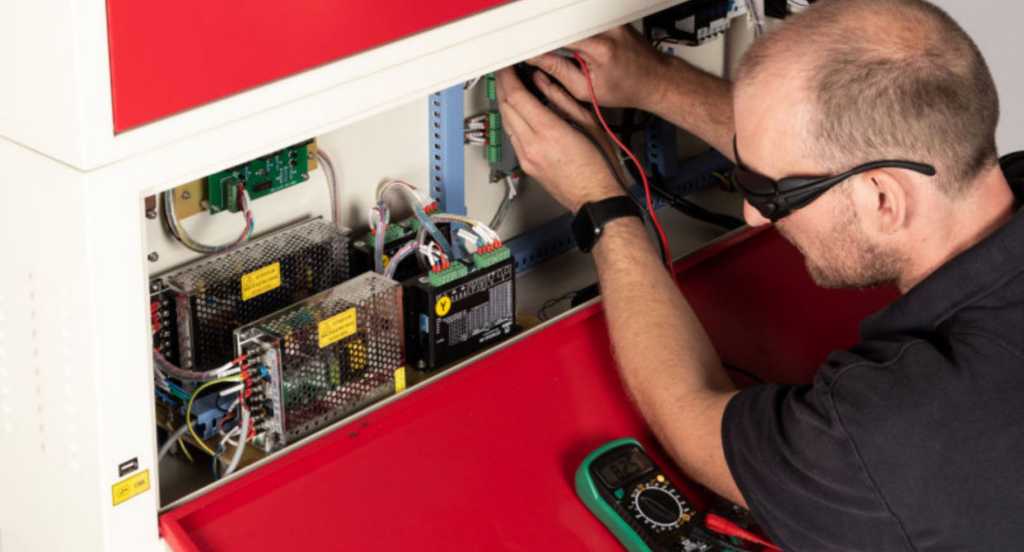Is the precision of your laser cut iron sheet up to the mark? Yes, laser cut iron sheets are very precise and reliable for metal fabrication.
With years of expertise in metal fabrication, the understanding of fine details that truly matter is well grasped. Rely on this experience for proper guidance.
Laser cut iron sheets represent a transformation in metal fabrication, offering unmatched precision and efficiency. They are very reliable and accurate, which makes them really important for today’s businesses.
This guide covers the essential aspects of laser cutting technology, offering insights into its impact on business operations.
So keep reading to learn more!
1. Understanding Laser Cutting in Metalwork
Laser engraving is a process where a laser beam is used to create precise markings on various materials. This technology is highly accurate, allowing for intricate designs that are too complex for traditional engraving methods. Laser engraving, like metal laser cutting, uses a high-power laser to vaporize materials for marking. It’s especially popular in metalwork for its precision and the ability to create detailed, lasting marks.
It’s amazing how a beam of light can etch such fine details, whether it’s cutting through metal or engraving intricate designs. Laser engraving’s efficiency aligns with its industry’s growth, with the laser cutting machine market projected to grow at a 7.5% CAGR from 2023 to 2032, reaching over USD 5.5 billion in 2022, per GMI. Laser engraving offers a fast and consistent way to create intricate patterns, unlike the slower, manual method.

2. Advantages of Laser Cutting Over Traditional Methods
After exploring the basics of laser engraving, it’s clear that laser cutting holds several advantages over traditional methods. Below are the key advantages of laser cutting over traditional methods:
Increased Precision
Laser cutting offers unparalleled accuracy, allowing for intricate cuts and detailed patterns that are not possible with traditional cutting methods. This precision is crucial in industries where detail is paramount. Additionally, it enables the production of complex shapes without the need for additional finishing, saving time and resources.

Minimal Maintenance
Lasers have fewer moving parts compared to traditional machinery, which translates to lower maintenance needs and costs. This longevity and reliability reduce downtime and increase productivity. The simplified maintenance routine means less technical training is required for staff. It’s impressive how such advanced technology can actually simplify our work.
No Tool Wear
Since laser cutting is a non-contact process, there’s no tool wear, meaning the quality of the cut remains consistent over time. This consistency is vital for businesses that need to maintain high standards for their products. Also, the absence of physical cutting tools means there are no costs associated with tool replacement and repair, for instance, the frequent changing of blades in traditional cutting methods.
Reduced Material Waste
Laser cutting is incredibly precise, which results in minimal material waste, making it a more sustainable option. The ability to maximize material usage not only reduces costs but also aligns with environmentally friendly practices. In addition, this efficiency is beneficial for companies aiming to adhere to strict waste management regulations.
3. Advanced Techniques in Laser Cutting Iron Sheets
After delving into the advantages, it’s evident that this technology is not just about cutting, but also about advanced techniques that enhance the final product. Below are some of the advanced techniques in laser cutting iron sheets:
Pulse Laser Cutting
This technique involves using a pulsed laser for cutting, which is particularly effective for thick iron sheets, allowing for precise control and reducing heat impact on the material. The pulsed nature of the laser minimizes the possibility of warping or damaging the material, making it ideal for delicate or complex projects. Additionally, it provides cleaner edges and finer details, which are crucial for high-quality finishes.
3D Laser Cutting
This innovative approach allows for cutting complex three-dimensional shapes, offering more versatility in design and application. It’s particularly useful for creating intricate components in the automotive and aerospace industries. It’s fascinating to see how laser technology brings intricate designs to life, especially in such high-precision fields.
Automated Laser Cutting
Integration with computer-aided design (CAD) and computer-aided manufacturing (CAM) systems allows for automated, repeatable, and precise cuts, essential for large-scale production. This automation ensures consistent quality across all pieces and reduces the chances of human error. It also allows for quick adjustments or customization, making it a flexible solution for various applications.
4. The Process of Laser Cutting Iron Sheets
After unveiling the advanced techniques in laser cutting, it’s essential to understand the step-by-step process involved in laser cutting iron sheets. Below are the steps in this process:
Step#1 Design Preparation
The process begins with preparing a detailed design using computer-aided design (CAD) software. This design acts as a guide for the laser cutter. The accuracy of this initial design is crucial as it directly impacts the final outcome. Any modifications or adjustments needed are also made in this stage to ensure the design is fully optimized for laser cutting.
Step#2 Material Selection and Setup
Choose the right quality and thickness of iron sheets for the project. The sheets are then properly positioned on the laser cutting table. Ensuring the material is flat and secure is vital for accurate cutting. The material’s properties, such as thickness and grade, determine the laser settings and cutting approach. It’s like setting the stage for a flawless performance, where every detail matters.
Step#3 Machine Configuration
The laser cutting machine is configured based on the material and design requirements. This includes setting the laser power, speed, and focus. Precise configuration is essential for achieving the desired cutting quality and preventing material damage. The machine’s settings are often fine-tuned based on the specific type and thickness of the iron sheet.
Step#4 Pilot Run
A pilot run is often conducted to ensure the settings are correct and the design is accurately translated onto the material. This test run helps identify any potential issues before the actual cutting begins, saving time and resources. For example, it can reveal if the laser intensity needs adjustment to prevent burning or under-cutting the material. It also allows for last-minute adjustments to the machine settings if needed.
Step#5 Cutting Process
The laser cutter then precisely follows the CAD design, cutting the iron sheets with high precision and speed. The laser beam moves along the predetermined path, melting, burning, or vaporizing the material. Throughout the process, the consistency of the laser beam ensures uniformity in the cut quality across the entire sheet. This careful method always gives neat and precise cuts.
Step#6 Quality Inspection
Following the cutting process, every piece is rigorously inspected for accuracy and quality, including dimension checks and edge smoothness. This crucial step ensures no defects are present, guaranteeing the final product meets the highest standards and is fully fit for purpose. It’s impressive how each piece is thoroughly inspected for quality, ensuring it meets strict standards and is perfect for use.
Step#7 Post-Processing
Any necessary post-processing, such as cleaning or additional finishing, is conducted to prepare the pieces for their final use or assembly. This may include removing any residual burrs, applying protective coatings, or conducting further machining. The goal of post-processing is to enhance the aesthetics and functionality of the cut pieces.
5. Laser Cutting vs. Traditional Cutting Methods
After understanding the detailed process of laser cutting, it becomes crucial to compare it with traditional cutting methods. Below are the comparisons between Laser Cutting and Traditional Cutting Methods:
Precision and Accuracy
Laser cutting offers a level of precision that traditional methods can’t match. The laser’s ability to make fine, detailed cuts results in more accurate and consistent products. This precision is crucial for applications where even the slightest deviation can compromise the integrity of the design. It’s truly remarkable how laser cutting turns complex designs into reality with such exactness.
Speed and Efficiency
Laser cutting is significantly faster than traditional methods, especially for complex or intricate designs. This speed is not just about cutting time; it’s also about reducing the time from design to production. The direct transfer of digital designs to the cutting machine eliminates many preparatory steps required in traditional methods. Additionally, the ability to process multiple parts simultaneously further boosts efficiency.
Material Handling and Safety
Lasers minimize the need for physical handling of materials, reducing the risk of injury. Traditional methods often require more manual intervention, increasing the potential for accidents. The automated nature of laser cutting not only enhances safety but also ensures consistent quality, as human error is greatly reduced. Moreover, the enclosed cutting area of laser machines provides additional safety benefits.
Flexibility in Design
Laser cutting allows for greater design flexibility, with the ability to easily make changes or adjustments. Traditional cutting methods are generally more rigid, requiring more time and resources to alter a design. This flexibility is particularly advantageous in prototype development and custom manufacturing, where designs often evolve. Lasers can adapt quickly to these changes, making them ideal for innovative projects.
6. Safety Measures in Laser Cutting Operations
After comparing laser cutting with traditional methods, it’s evident that safety is a must in these high-tech operations. Below are the key safety measures in laser cutting operations:
Proper Training
Operators must be thoroughly trained in using laser cutting machines, understanding both the equipment’s capabilities and potential hazards. This training should include both theoretical knowledge and hands-on experience. Regular refresher courses are also vital to keep the operators updated on the latest safety standards and technological advancements.
Use of Protective Gear
It’s essential to wear appropriate safety gear, such as safety glasses to protect eyes from laser reflections and sturdy gloves to handle materials safely. Additionally, protective clothing should be worn to guard against potential burns and exposure to harmful particulates. Zemetal consistently emphasizes the importance of these safety measures in all their workshops and training sessions.
Regular Maintenance Checks
Regular inspections and maintenance of laser cutting machines help prevent malfunctions that could lead to accidents. These checks should include examining the laser alignment, ensuring proper functioning of safety interlocks, and verifying the condition of all moving parts. A well-maintained machine is not only safer but also performs more efficiently and reliably.

Adequate Ventilation
Ensuring proper ventilation in the working area is crucial to disperse any fumes or vapors produced during the cutting process. This includes installing exhaust systems and air filtration units to maintain a clean and safe air quality. Regular testing of the ventilation system also ensures it continues to operate effectively, providing a healthy environment for operators.
7. Challenges and Considerations in Laser Cutting
After addressing the safety measures in laser cutting operations, lwt’s now recognize the challenges and considerations unique to this technology. Below are the challenges and considerations in laser cutting:
Material Limitations
Not all materials are suitable for laser cutting, and the technology’s effectiveness varies depending on the type of material and its thickness. Materials with high reflectivity, like copper and aluminum, can pose challenges, while others might get damaged or burn easily. Understanding material properties is therefore essential to determine their suitability for laser cutting.
This table provides an overview of five common materials used in laser cutting, highlighting their suitability and challenges:
| Material | Suitability for Laser Cutting | Challenges |
| Acrylic | Highly suitable | Prone to producing a polished edge |
| Mild Steel | Very suitable | Requires high power for thicker sections |
| Aluminum | Moderately suitable | High reflectivity can cause issues |
| Wood | Suitable | Risk of burning or charring |
| Copper | Least suitable | Extremely reflective and requires caution |
Heat Affected Zone (HAZ)
The intense heat generated by the laser can affect the material around the cut, potentially altering its properties or appearance. This can lead to issues like warping or changes in material strength, which are crucial factors in precision engineering. Mitigating the effects of HAZ requires careful control of laser parameters and cutting techniques.
Cost of Equipment and Maintenance
While laser cutting is cost-effective in the long run, the initial investment in equipment and ongoing maintenance costs can be significant. High-quality lasers and the necessary supporting systems represent a substantial capital outlay. Additionally, specialized training for operators and regular maintenance add to the operational costs.
Precision and Complexity Limits
There are limits to the level of detail and complexity that can be achieved, which varies depending on the laser’s capabilities and the material used. While lasers can create incredibly intricate designs, extremely small or complex features might be challenging to produce accurately. This necessitates a balance between design aspirations and the practical capabilities of the laser cutting equipment.
Environmental Impact
The process of laser cutting, particularly when cutting certain materials, can produce fumes and waste that need to be managed responsibly. Effective extraction and filtration systems are essential to minimize air pollution. It’s a crucial balance, ensuring innovative work respects and protects the environment.I’ve realized that being eco-friendly isn’t just great for the environment, it’s actually great for the business as well.
8. 5 Factors to Consider When Selecting the Right Laser Cutting ServiceS
After discussing the challenges and considerations in laser cutting, it’s vital to know what factors to consider when choosing the right laser cutting service. Below are the factors to consider:
#1 Experience and Expertise
Look for a service provider with a strong track record and expertise in laser cutting. Experienced professionals can handle complex projects and provide valuable insights. They also tend to have a better grasp of the nuances of various materials and can provide solutions specifically suited to individual needs. A well-established provider will have a portfolio or case studies that showcase their capability and quality of work.
#2 Quality of Machinery
The quality and capabilities of the laser cutting machinery used by the service are critical. Advanced machines offer better precision, speed, and versatility in handling various materials. High-quality equipment also means less downtime due to maintenance issues, ensuring a smoother workflow. It’s incredible how the right machine can turn challenging projects into masterpieces of precision.
#3 48-Hour Rapid Turnaround Time
Think about the provider’s capability to fulfill deadlines. Efficient services can deliver high-quality work within the required timeframe, such as offering a 48-hour rapid turnaround option for urgent projects. Speed should not compromise the quality of the end product, so look for a balance between swift delivery and meticulous workmanship. Reliable providers will clearly communicate timelines and any potential delays.
#4 Cost-Effectiveness
Examine the service’s pricing structure to ensure it fits within the budget while maintaining high quality.While cost is a significant factor, the cheapest option may not always offer the best value. Assess the overall value proposition, considering factors like quality, reliability, and after-sales service. A good service provider will be transparent about their pricing and offer a detailed quotation.
#5 Customer Service and Support
Good communication and customer support are essential.Select a service known for its responsiveness, transparency, and commitment to close collaboration throughout the project. This includes offering advice on design optimization, material selection, and post-processing options.Zemetal is known for offering personalized attention and expert guidance at every stage of the project.
Conclusion
In this comprehensive guide, we’ve explored the intricacies and benefits of laser cutting and engraving in metalwork.Embracing these technologies significantly boosts precision, efficiency, and creativity in projects.
For those seeking to harness the power of laser cutting, Zemetal stands as the ideal partner. Reach out for customized solutions and begin crafting something extraordinary today!
Dive Deeper Into Our Resources
Looking for more diverse service options? Browse through our handpicked selections:
Still haven’t found what you’re looking for? Don’t hesitate to contact us. We’re available around the clock to assist you.








